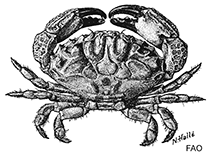Lophozozymus pictor (Fabricius, 1798)
Mosaic reef crab| Native range | All suitable habitat | Point map | Year 2050 |

|
| This map was computer-generated and has not yet been reviewed. |
| Lophozozymus pictor AquaMaps Data sources: GBIF OBIS |
Google image | No image available for this species;
drawing shows typical species in Xanthidae.
Classification / Names आम नाम | उपशब्द | CoL | ITIS | WoRMS
Malacostraca | Decapoda | Xanthidae
Environment: milieu / climate zone / गहराई सीमा / distribution range पारिस्थितिकी
प्रवाल-भित्ति संयुक्त; गहराई सीमा 0 - 5 m (संदर्भ 96667). Tropical
Distribution देश | ऐफ ऐ ओ क्षेत्र | Ecosystems | संयोग | भूमिका
Indo-Pacific.
Length at first maturity / आकार / Weight / Age
परिपक्व अवधि: Lm ? range ? - ? cm Max length : 10.0 cm CW पुल्लिंग / अलिंग; (संदर्भ 128968); अधिकतम प्रकाशित वज़न: 100.00 g (संदर्भ 128968)
Short description आकृति विज्ञान
Life cycle and mating behavior परिपक्व अवधि | पुनरुत्पत्ति | मछलीऔ का अंडे देना | Eggs | Fecundity | Larvae
Main reference
संदर्भ | संयोजक | सहयोगीयो
Yeo, D.C.J., T. Swee Hee and P.K.L. Ng. 2008. (संदर्भ 85383)
IUCN Red List Status
(संदर्भ 130435: Version 2024-2)
CITES status (संदर्भ 108899)
CMS (संदर्भ 116361)
Threat to humans
Human uses
| FishSource |
साधन
अधिक जानकारी
संघटक आहार
आहार खपत
परभक्षी
इंटरनेट स्रोत
BHL | BOLD Systems | CISTI | DiscoverLife | FAO(Publication : search) | Fishipedia | GenBank (genome, nucleotide) | GloBI | Gomexsi | Google Books | Google Scholar | Google | PubMed | Tree of Life | Wikipedia (Go, खोज) | Zoological Record



